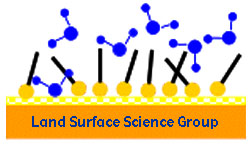Land Surface Science Group
INSTRUMENTATION
The apparatus to carry out the bulk of the experiments are custom-designed instruments combining techniques at the forefront of molecular surface analysis. The design and construction of instrumentation is a continuing process. Virtually every component is specially designed to accommodate the new technologies and approach for our projects. Many items are manufactured entirely here at UC Davis by the graduate students in our machine, glass, and electronics shops.
SURFACE MOLECULAR COMPOSITION
Thermal desorption (TDS), laser desorption (LITD), Fourier transform mass spectrometery (FTMS), FT reflection absorption infrared spectroscopy (FTRAIRS), Auger electron (AES) and X-ray photoelectron (XPS) spectroscopies are used to ascertain the molecular composition of adsorbates in ultra-high vacuum for a variety of samples. The infrared and electron spectroscopies monitor the surface composition in situ, requiring little or no perturbation of the sample. Of these, FTRAIRS, which bounces an IR beam off the surface at a low angle, is the least perturbing and gives the most chemical information. When the IR beam interacts with the surface, vibrational modes of adsorbed species can absorb energy, leading to an IR spectrum. Selection rules can be used to ascertain the molecular identity and orientation on the surface. Changes can be monitored to infer surface chemistry.
Removal of the adsorbed species (desorption) allows them to be monitored by mass spectrometry, a very powerful moleuclar analysis technique. Two methods for achieving desorption are used. One is to simply heat the entire surface with electric current (directly or with and adjacent heater coil) at about 10 K/s and observe the gases that are evolved (TDS). Mass spectrometry gives the molecular identity of the desorbing species and the temperatures and amounts can be used to infer surface reaction mechanisms. A second method of inducing desorption is to rapidly (10 ns) heat a small (1 mm 2) region with a pulsed laser (LITD). The rapid laser heating can cause species to desorb before they react further, giving a snapshot of the surface composition at the time of the laser firing. When LITD is coupled with FTMS, the surface molecular composition can be probed rapidly and repeatedly to allow kinetics studies of adsorbed reacting systems.







